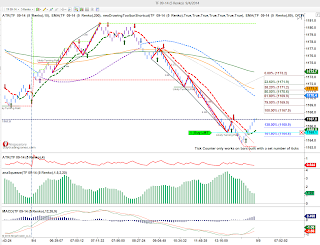Times and activities on a scheduled trading day
Pre-market (planning and analysis time)
We generally start our day at 7am CST (1pm UK time). This is a low key slow start period of the day in which we evaluate the overnight activity and develop our plan of attack for the day.
There are very rare pre-open trades but these are not common. Carrying positions through the open is difficult, so a pre-market trade is likely to be a small scalp only.
Consequently this is our lowest priority session of the day and somewhat less than half of our members choose to be online at this time.
Morning (a high activity, top priority time)
Once the market opens at 8:30am CST (2:30pm UK time) we shift gears dramatically. This session is the most important time of day when everyone who can, should be trading and focused on the market.
Most days there is news at 9:00am CST. So any position opened in the first half hour needs to have the risk out of it as a minimum, if it is to be held through the news. After this time the field is usually clear to initiate and/or hold trades throughout the morning.
Depending on how the morning develops we will determine how long to hold and how best to manage a position. The first priority is always to get the initial risk out as quickly as possible, which may mean exiting in pieces and/or trailing our stop.
Lunchtime (activity dies off - take a break!)
By about 11:15am CST (5:15pm UK time) activity and volume starts to die off as traders in Chicago and New York go off to lunch. Traders in Europe are also going home for the day.
Lunchtime is therefore the lowest probability time of the day to be trading and hence is the ideal time for us to take a 60 to 90 minute break.
Most of the time we will close positions at the end of the morning session and be flat over lunchtime. The exception to this would be on a trend day when we may elect to hold a full or partial position through lunchtime with the expectation of continuation in the afternoon session.
Afternoon (lower activity, 3rd priority time)
Any time from about 12.45pm CST (6:45pm UK time) the market starts to wake up again. Volume and activity levels improve and we start to watch for new opportunities.
Unlike the morning session which we enter without knowing what sort of day will actually unfold, as we go into the afternoon the nature of the day we are dealing with is known. Consequently this is a much less intense period of trading, generally with much more notice that we are looking to take a position or not.
We take fewer trades in the afternoon than the morning and as a rule they will be played for smaller profits. Therefore this is a good time of day to be trading, but it is far less important than the morning session.
Close (often active, 2nd priority time)
The last hour of the day can provide a number of specific opportunities overlooked by the majority of traders. Along with the open, the close is the highest volume time of day. But unlike the open, we know the type of day that has been playing out as we go into the close and therefore can choose to deploy one of three specific tactics designed to capture moves at this time of day.
Because of the unique nature of the close and the speed at which profits can be achieved, the close has become our second most important period of the day to be active in the market. We even have members who are working towards only trading this time of day!












